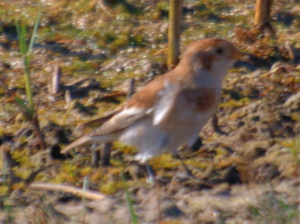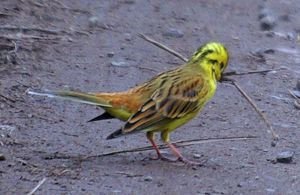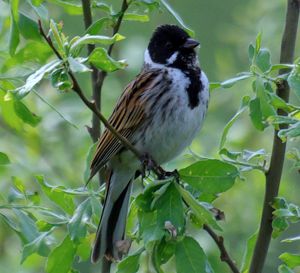


The Snow Bunting is a scarce passage migrant and winter visitor to Nottinghamshire. It visits us at the average of 1 to 2 birds a year. Old grassed-over coal pit tops are a favourite as they appear similar habitat to their summer breeding grounds.
From what Sterland says in Descriptive List of the Birds of Nottinghamshire {1879} it appeared to be a commoner visitor in the 1850s. The winters were colder then of course.

The Yellowhammer is one of the commoner Nottinghamshire birds, it is found on heathland and hedges especially those bordering pasture land. The male Yellowhammer needs a few trees (or overhead cables) for a song post in the breeding season. The Nottinghamshire breeding populations are at places such as Budby Heath, Papplewick and the Cossall/Trowell area. In the winter does not move far from its breeding territory, 3 or 4 miles at the most, and there is no great influx from the Continent in the autumn.
The Yellowhammer has shown a slight decrease in numbers in the East Midlands over the past 13 years (Breeding Birds Survey – East Midlands). Sterland in the Descriptive List of the Birds of Nottinghamshire {1879} called the Yellowhammer or as he called it, Yellow Bunting, "A very common resident, but more plentiful I think in summer than in winter".

Reed Buntings are classed as a fairly common resident in Nottinghamshire. In the summer found mainly in the scrubby areas close to gravel pits, lakes and similar wet areas, but in high population times it will breed out on suitable farmland. For Nottinghamshire the main breeding populations are at places such as Langford Lowfields, Lound and Netherfield Lagoons. In the winter Reed Buntings will move out more into the local fields and available rough ground to feed on seeds. There is little immigration or emigration of birds for the winter.
The Reed Bunting has shown a slight increase in population over the past 13 years (Breeding Birds Survey – East Midlands). Sterland {1869 & 1879} thought the Reed Bunting was a common resident in the nineteenth century.
The Reed Bunting has been called the Black–headed Bunting and Reed Sparrow in the past.
Any criticisms, corrections or comments to the author Derek Huskisson

This work is licensed under a Creative Commons Attribution-Noncommercial-Share Alike 2.0 UK: England & Wales License.